Scaffold-Hopping Strategies in Aurone Optimization: A Comprehensive Review of Synthetic Procedures and Biological Activities of Nitrogen and Sulfur Analogues
Abstract
:1. Introduction
2. Bioisosteric Scaffold-Hopped Analogues of Natural Aurones
2.1. Indolin-3-One Derivatives (Azaaurones)
2.1.1. Synthetic Procedures: Scaffold Formation
2.1.2. Synthetic Procedures: Scaffold Elaboration
2.1.3. Biological Activities
2.2. Imidazo[1,2-a]pyridin-3-one Derivatives
2.2.1. Synthetic Procedures
2.2.2. Biological Activities
2.3. Thioaurone Derivatives
2.3.1. Synthetic Procedures
2.3.2. Biological Activities
3. Conclusions and Future Directions
Author Contributions
Funding
Acknowledgments
Conflicts of Interest
References
- Atanasov, A.G.; Zotchev, S.B.; Dirsch, V.M.; Supuran, C.T.; Taskforce, I.N.P.S. Natural products in drug discovery: Advances and opportunities. Nat. Rev. Drug Discov. 2021, 20, 200–216. [Google Scholar] [CrossRef] [PubMed]
- Dzobo, K. The Role of Natural Products as Sources of Therapeutic Agents for Innovative Drug Discovery. In Comprehensive Pharmacology; National Library of Medicine: Bethesda, MD, USA, 2022; Volume 2, pp. 408–422. [Google Scholar]
- Panche, A.N.; Diwan, A.D.; Chandra, S.R. Flavonoids: An overview. J. Nutr. Sci. 2016, 5, e47. [Google Scholar] [CrossRef] [PubMed]
- Liga, S.; Paul, C.; Péter, F. Flavonoids: Overview of Biosynthesis, Biological Activity, and Current Extraction Techniques. Plants 2023, 12, 2732. [Google Scholar] [CrossRef] [PubMed]
- Ninomiya, M.; Koketsu, M. Minor Flavonoids (Chalcones, Flavanones, Dihydrochalcones, and Aurones). In Natural Products: Phytochemistry, Botany and Metabolism of Alkaloids, Phenolics and Terpenes; Springer: Berlin/Heidelberg, Germany, 2013; pp. 1867–1900. [Google Scholar]
- Sui, G.; Li, T.; Zhang, B.; Wang, R.; Hao, H.; Zhou, W. Recent advances on synthesis and biological activities of aurones. Bioorg. Med. Chem. 2021, 29, 115895. [Google Scholar] [CrossRef] [PubMed]
- Alsayari, A.; Muhsinah, A.B.; Hassan, M.Z.; Ahsan, M.J.; Alshehri, J.A.; Begum, N. Aurone: A biologically attractive scaffold as anticancer agent. Eur. J. Med. Chem. 2019, 166, 417–431. [Google Scholar] [CrossRef] [PubMed]
- Popova, A.V.; Bondarenko, S.P.; Frasinyuk, M.S. Aurones: Synthesis and Properties. Chem. Heterocycl. Compd. 2019, 55, 285–299. [Google Scholar] [CrossRef]
- Boumendjel, A. Aurones: A subclass of flavones with promising biological potential. Curr. Med. Chem. 2003, 10, 2621–2630. [Google Scholar] [CrossRef] [PubMed]
- Mazziotti, I.; Petrarolo, G.; La Motta, C. Aurones: A Golden Resource for Active Compounds. Molecules 2021, 27, 2. [Google Scholar] [CrossRef] [PubMed]
- Zwergel, C.; Gaascht, F.; Valente, S.; Diederich, M.; Bagrel, D.; Kirsch, G. Aurones: Interesting natural and synthetic compounds with emerging biological potential. Nat. Prod. Commun. 2012, 7, 389–394. [Google Scholar] [CrossRef]
- Yang, J.; Gao, Z.; Yu, Z.; Hou, Y.; Tang, D.; Yan, H.; Wu, F.; Chang, S.K.; Pan, Y.; Jiang, Y.; et al. An update of aurones: Food resource, health benefit, biosynthesis and application. Crit. Rev. Food Sci. Nutr. 2023, 1–20. [Google Scholar] [CrossRef]
- Boucherle, B.; Peuchmaur, M.; Boumendjel, A.; Haudecoeur, R. Occurrences, biosynthesis and properties of aurones as high-end evolutionary products. Phytochemistry 2017, 142, 92–111. [Google Scholar] [CrossRef] [PubMed]
- Böhm, H.J.; Flohr, A.; Stahl, M. Scaffold hopping. Drug Discov. Today Technol. 2004, 1, 217–224. [Google Scholar] [CrossRef] [PubMed]
- Zhao, H. Scaffold selection and scaffold hopping in lead generation: A medicinal chemistry perspective. Drug Discov. Today 2007, 12, 149–155. [Google Scholar] [CrossRef] [PubMed]
- Sun, H.; Tawa, G.; Wallqvist, A. Classification of scaffold-hopping approaches. Drug Discov. Today 2012, 17, 310–324. [Google Scholar] [CrossRef] [PubMed]
- Hu, Y.; Stumpfe, D.; Bajorath, J. Recent Advances in Scaffold Hopping. J. Med. Chem. 2017, 60, 1238–1246. [Google Scholar] [CrossRef] [PubMed]
- Acharya, A.; Yadav, M.; Nagpure, M.; Kumaresan, S.; Guchhait, S.K. Molecular medicinal insights into scaffold hopping-based drug discovery success. Drug Discov. Today 2023, 29, 103845. [Google Scholar] [CrossRef] [PubMed]
- Gerby, B.; Boumendjel, A.; Blanc, M.; Bringuier, P.P.; Champelovier, P.; Fortuné, A.; Ronot, X.; Boutonnat, J. 2-Arylidenedihydroindole-3-ones: Design, synthesis, and biological activity on bladder carcinoma cell lines. Bioorg. Med. Chem. Lett. 2007, 17, 208–213. [Google Scholar] [CrossRef] [PubMed]
- Campaniço, A.; Harjivan, S.G.; Freitas, E.; Serafini, M.; Gaspar, M.M.; Capela, R.; Gomes, P.; Jordaan, A.; Madureira, A.M.; André, V.; et al. Structural Optimization of Antimycobacterial Azaaurones Towards Improved Solubility and Metabolic Stability. ChemMedChem 2023, 18, e202300410. [Google Scholar] [CrossRef]
- Watanabe, H.; Ono, M.; Kimura, H.; Matsumura, K.; Yoshimura, M.; Okamoto, Y.; Ihara, M.; Takahashi, R.; Saji, H. Synthesis and biological evaluation of novel oxindole derivatives for imaging neurofibrillary tangles in Alzheimer’s disease. Bioorg. Med. Chem. Lett. 2012, 22, 5700–5703. [Google Scholar] [CrossRef]
- Shu, C.; Li, L.; Xiao, X.Y.; Yu, Y.F.; Ping, Y.F.; Zhou, J.M.; Ye, L.W. Flexible and practical synthesis of 3-oxyindoles through gold-catalyzed intermolecular oxidation of o-ethynylanilines. Chem. Commun. 2014, 50, 8689–8692. [Google Scholar] [CrossRef]
- Petermayer, C.; Thumser, S.; Kink, F.; Mayer, P.; Dube, H. Hemiindigo: Highly Bistable Photoswitching at the Biooptical Window. J. Am. Chem. Soc. 2017, 139, 15060–15067. [Google Scholar] [CrossRef] [PubMed]
- Duindam, N.; van Dongen, M.; Siegler, M.A.; Wezenberg, S.J. Monodirectional Photocycle Drives Proton Translocation. J. Am. Chem. Soc. 2023, 145, 21020–21026. [Google Scholar] [CrossRef] [PubMed]
- Malbari, K.; Saha, P.; Chawla-Sarkar, M.; Dutta, S.; Rai, S.; Joshi, M.; Kanyalkar, M. In quest of small-molecules as potent non-competitive inhibitors against influenza. Bioorg. Chem. 2021, 114, 105139. [Google Scholar] [CrossRef] [PubMed]
- Abonia, R.; Cuervo, P.; Castillo, J.; Insuasty, B.; Quiroga, J.; Nogueras, M.; Cobo, J. Unexpected intramolecular cyclization of some 2′-aminochalcones to indolin-3-ones mediated by Amberlyst®-15. Tetrahedron Lett. 2008, 49, 5028–5031. [Google Scholar] [CrossRef]
- Genelot, M.; Bendjeriou, A.; Dufaud, V.; Djakovitch, L. Optimised procedures for the one-pot selective syntheses of indoxyls and 4-quinolones by a carbonylative Sonogashira/cyclisation sequence. Appl. Catal. A Gen. 2009, 369, 125–132. [Google Scholar] [CrossRef]
- Genelot, M.; Dufaud, V.; Djakovitch, L. Heterogeneous metallo-organocatalysis for the selective one-pot synthesis of 2-benzylidene-indoxyl and 2-phenyl-4-quinolone. Tetrahedron 2011, 67, 976–981. [Google Scholar] [CrossRef]
- Xiong, W.; Wu, B.; Zhu, B.; Tan, X.; Wang, L.; Wu, W.; Qi, C.; Jiang, H. One-Pot Palladium-Catalyzed Carbonylative Sonogashira Coupling using Carbon Dioxide as Carbonyl Source. ChemCatChem 2021, 13, 2843–2851. [Google Scholar] [CrossRef]
- Song, X.; Zhao, X.; Zeng, Z.; Rominger, F.; Rudolph, M.; Hashmi, A.S.K. Protecting Group-Free Gold-Catalyzed Synthesis of 2-Acylidene-3-Oxindoles and Azaaurones via a Double Oxidation Strategy. Isr. J. Chem. 2023, 63, e202300094. [Google Scholar] [CrossRef]
- Zhu, Y.L.; Dong, Y.F.; Wang, S.R.; Li, Y.G.; Wu, X.; Ye, L.W. Nucleophile-Controlled Trapping of Gold Carbene by Nitriles and Water: Synthesis of 5H-Pyrimido [5,4-b]indoles and 2-Benzylidene-3-indolinones. Org. Lett. 2023, 26, 631–635. [Google Scholar] [CrossRef]
- Aksenov, N.A.; Aksenov, D.A.; Arutiunov, N.A.; Aksenova, D.S.; Aksenov, A.V.; Rubin, M. Unexpected cyclization of ortho-nitrochalcones into 2-alkylideneindolin-3-ones. RSC Adv. 2020, 10, 18440–18450. [Google Scholar] [CrossRef]
- Aksenov, N.A.; Aksenov, A.V.; Kurenkov, I.A.; Kirillov, N.K.; Aksenov, D.A.; Arutiunov, N.A.; Aksenova, D.S.; Rubin, M. One-Pot Synthesis of (E)-2-(3-Oxoindolin-2-ylidene)-2-arylacetonitriles. Molecules 2022, 27, 2808. [Google Scholar] [CrossRef]
- Aksenov, N.A.; Aksenov, A.V.; Prityko, L.A.; Aksenov, D.A.; Aksenova, D.S.; Nobi, M.A.; Rubin, M. Oxidative Cyclization of 4-(2-Aminophenyl)-4-oxo-2-phenylbutanenitriles into 2-(3-Oxoindolin-2-ylidene)acetonitriles. ACS Omega 2022, 7, 14345–14356. [Google Scholar] [CrossRef]
- Sacherer, M.; Hampel, F.; Dube, H. Diaryl-hemiindigos as visible light, pH, and heat responsive four-state switches and application in photochromic transparent polymers. Nat. Commun. 2023, 14, 4382. [Google Scholar] [CrossRef]
- Souard, F.; Okombi, S.; Beney, C.; Chevalley, S.; Valentin, A.; Boumendjel, A. 1-Azaaurones derived from the naturally occurring aurones as potential antimalarial drugs. Bioorg. Med. Chem. 2010, 18, 5724–5731. [Google Scholar] [CrossRef]
- Carrasco, M.P.; Newton, A.S.; Gonçalves, L.; Góis, A.; Machado, M.; Gut, J.; Nogueira, F.; Hänscheid, T.; Guedes, R.C.; dos Santos, D.J.; et al. Probing the aurone scaffold against Plasmodium falciparum: Design, synthesis and antimalarial activity. Eur. J. Med. Chem. 2014, 80, 523–534. [Google Scholar] [CrossRef]
- Carrasco, M.P.; Machado, M.; Gonçalves, L.; Sharma, M.; Gut, J.; Lukens, A.K.; Wirth, D.F.; André, V.; Duarte, M.T.; Guedes, R.C.; et al. Probing the Azaaurone Scaffold against the Hepatic and Erythrocytic Stages of Malaria Parasites. ChemMedChem 2016, 11, 2194–2204. [Google Scholar] [CrossRef] [PubMed]
- Adhikari, N.; Halder, A.K.; Mondal, C.; Jha, T. Exploring structural requirements of aurone derivatives as antimalarials by validated DFT-based QSAR, HQSAR, and COMFA-COMSIA approach. Med. Chem. Res. 2013, 22, 6029–6045. [Google Scholar] [CrossRef]
- Sharma, M.C.; Sharma, S.; Sharma, P.; Kumar, A. Pharmacophore and QSAR modeling of some structurally diverse azaaurones derivatives as anti-malarial activity. Med. Chem. Res. 2014, 23, 181–198. [Google Scholar] [CrossRef]
- Hadni, H.; Elhallaoui, M. 2D and 3D-QSAR, molecular docking and ADMET properties: In silico studies of azaaurones as antimalarial agents. New J. Chem. 2020, 44, 6553–6565. [Google Scholar] [CrossRef]
- Hadni, H.; Elhallaoui, M. 3D-QSAR, docking and ADMET properties of aurone analogues as antimalarial agents. Heliyon 2020, 6, e03580. [Google Scholar] [CrossRef]
- Campaniço, A.; Carrasco, M.P.; Njoroge, M.; Seldon, R.; Chibale, K.; Perdigão, J.; Portugal, I.; Warner, D.F.; Moreira, R.; Lopes, F. Azaaurones as Potent Antimycobacterial Agents Active against MDR- and XDR-TB. ChemMedChem 2019, 14, 1537–1546. [Google Scholar] [CrossRef] [PubMed]
- Yang, D.; Taylor, Z.E.; Handy, S.; Li, S.; Liu, J.; Stabenow, J.; Zalduondo, L.; Jonsson, C.B.; Altman, E.; Kong, Y. Identification of Anti-tuberculosis Compounds From Aurone Analogs. Front. Microbiol. 2020, 11, 1004. [Google Scholar] [CrossRef] [PubMed]
- Kong, Y.; Yang, D.; Taylor, Z.E.; Handy, S.; Altman, E. Aurones and Methods of Using Aurones to Treat Tuberculosis. PCT/US2020/030623, 5 November 2020. [Google Scholar]
- Zhang, M.; Li, T.; Qian, M.; Li, K.; Qin, Y.; Zhao, T.; Yang, L.Q. Synthesis and Biological Activities of 1-Azaaurone Derivatives. J. Heterocycl. Chem. 2018, 55, 1574–1578. [Google Scholar] [CrossRef]
- Tóth, S.; Szepesi, Á.; Tran-Nguyen, V.K.; Sarkadi, B.; Német, K.; Falson, P.; Di Pietro, A.; Szakács, G.; Boumendjel, A. Synthesis and Anticancer Cytotoxicity of Azaaurones Overcoming Multidrug Resistance. Molecules 2020, 25, 764. [Google Scholar] [CrossRef] [PubMed]
- Li, Y.; Wang, J.; Song, N.; Zeng, F.; Zhao, M.; Wang, A.; Chen, Y.; Jing, L.; Yu, P.; Diao, A. 2-(2-nitrobenzylidene) indolin-3-one compound inhibits transmembrane prostate androgen-induced protein (TMEPAI) expression and cancer cell proliferation. Cell Prolif. 2018, 51, e12469. [Google Scholar] [CrossRef] [PubMed]
- Ermakova, Y.G.; Bogdanova, Y.A.; Baleeva, N.S.; Zaitseva, S.O.; Guglya, E.B.; Smirnov, A.Y.; Zagudaylova, M.B.; Baranov, M.S. Pyridine analogue of fluorescent protein chromophore: Fluorogenic dye suitable for mitochondria staining. Dye. Pigment. 2019, 170, 107550. [Google Scholar] [CrossRef]
- Smirnov, A.Y.; Perfilov, M.M.; Zaitseva, E.R.; Zagudaylova, M.B.; Zaitseva, S.O.; Mishin, A.S.; Baranov, M.S. Design of red-shifted and environment-sensitive fluorogens based on GFP chromophore core. Dye Pigment. 2020, 177, 108258. [Google Scholar] [CrossRef]
- Guchhait, S.K.; Priyadarshani, G.; Hura, N. α,β-Epoxy esters in multiple C-O/C-N bond-breaking/formation with 2-aminopyridines; Synthesis of biologically relevant (Z)-2- methyleneimidazo [1,2-a ]pyridin-3-ones. Synlett 2014, 25, 1692–1696. [Google Scholar] [CrossRef]
- Priyadarshani, G.; Nayak, A.; Amrutkar, S.M.; Das, S.; Guchhait, S.K.; Kundu, C.N.; Banerjee, U.C. Scaffold-Hopping of Aurones: 2-Arylideneimidazo [1,2-a]pyridinones as Topoisomerase IIα-Inhibiting Anticancer Agents. ACS Med. Chem. Lett. 2016, 7, 1056–1061. [Google Scholar] [CrossRef]
- Kumar, G.; Das, C.; Acharya, A.; Bhal, S.; Joshi, M.; Kundu, C.N.; Choudhury, A.R.; Guchhait, S.K. Organocatalyzed umpolung addition for synthesis of heterocyclic-fused arylidene-imidazolones as anticancer agents. Bioorg. Med. Chem. 2022, 67, 116835. [Google Scholar] [CrossRef]
- Sailer, A.; Ermer, F.; Kraus, Y.; Bingham, R.; Lutter, F.H.; Ahlfeld, J.; Thorn-Seshold, O. Potent hemithioindigo-based antimitotics photocontrol the microtubule cytoskeleton in cellulo. Beilstein J. Org. Chem. 2020, 16, 125–134. [Google Scholar] [CrossRef] [PubMed]
- Wiedbrauk, S.; Maerz, B.; Samoylova, E.; Reiner, A.; Trommer, F.; Mayer, P.; Zinth, W.; Dube, H. Twisted Hemithioindigo Photoswitches: Solvent Polarity Determines the Type of Light-Induced Rotations. J. Am. Chem. Soc. 2016, 138, 12219–12227. [Google Scholar] [CrossRef] [PubMed]
- Sailer, A.; Ermer, F.; Kraus, Y.; Lutter, F.H.; Donau, C.; Bremerich, M.; Ahlfeld, J.; Thorn-Seshold, O. Hemithioindigos for Cellular Photopharmacology: Desymmetrised Molecular Switch Scaffolds Enabling Design Control over the Isomer-Dependency of Potent Antimitotic Bioactivity. ChemBioChem 2019, 20, 1305–1314. [Google Scholar] [CrossRef] [PubMed]
- Duan, K.; An, X.D.; Li, L.F.; Sun, L.L.; Qiu, B.; Li, X.J.; Xiao, J. Hydride Transfer Initiated Redox-Neutral Cascade Cyclizations of Aurones: Facile Access to [6,5] Spirocycles. Org. Lett. 2020, 22, 2537–2541. [Google Scholar] [CrossRef] [PubMed]
- Zaher, A.F.; Abuel-Maaty, S.M.; El-Nassan, H.B.; Amer, S.A.; Abdelghany, T.M. Synthesis, antitumor screening and cell cycle analysis of novel benzothieno [3,2-b]pyran derivatives. J. Enzym. Inhib. Med. Chem. 2016, 31, 145–153. [Google Scholar] [CrossRef] [PubMed]
- Herre, S.; Steinle, W.; Rück-Braun, K. Synthesis of photoswitchable hemithioindigo-based ω-amino acids and application in Boc-based peptide assembly. Synthesis 2005, 2005, 3297–3300. [Google Scholar] [CrossRef]
- Dong, Z.H.; Li, S.; Long, T.; Zhan, J.; Ruan, C.K.; Yan, X.; Chu, W.D.; Yuan, K.; Liu, Q.Z. Copper-Catalyzed Enantioselective 1,2-Allylation of Azadienes with Allylboronates. Org. Lett. 2024, 26, 3235–3240. [Google Scholar] [CrossRef] [PubMed]
- Nguyen, T.B.; Retailleau, P. Cooperative Activating Effect of Tertiary Amine/DMSO on Elemental Sulfur: Direct Access to Thioaurones from 2′-Nitrochalcones under Mild Conditions. Org. Lett. 2018, 20, 186–189. [Google Scholar] [CrossRef] [PubMed]
- Kaur, M.; Suman, P.; Arora, S.; Singh, T.; Munshi, A.; Singh, S.; Kumar, R. Design, Synthesis, and Anticancer Evaluation of Hemithioindigos via Inhibition of Human Topoisomerases. ChemistrySelect 2023, 8, e202301700. [Google Scholar] [CrossRef]
- Yue, Y.; Dai, J.; Jin, L.; Liu, C.; Sun, J.; Ye, K.; Lu, R. The Factor beyond Schmidt’s Criteria Impacting the Photo-Induced [2+2] Cycloaddition Reactivity and Photoactuation of Molecular Crystals Based on Cyclic Chalcone Analogues. Chemistry 2023, 29, e202301525. [Google Scholar] [CrossRef]
- Venkateswarlu, S.; Murty, G.N.; Satyanarayana, M.; Siddaiah, V. Competitive cascade cyclization of 2′-tosyloxychalcones: An easy access to thioflavones and thioaurones. Synth. Commun. 2020, 50, 2347–2354. [Google Scholar] [CrossRef]
- Zheng, G.; Ma, X.; Liu, B.; Dong, Y.; Wang, M. Iodine-catalyzed intramolecular oxidative thiolation of vinylic carbon-hydrogen bonds via tandem iodocyclization and dehydroiodination: Construction of 2-methylene-3-thiophenones. Adv. Synth. Catal. 2014, 356, 743–748. [Google Scholar] [CrossRef]
- Soundarya, P.; Sekar, G. Cu-Catalyzed and iodine mediated synthesis of thioaurones via in situ C–S bond generation using xanthate as a sulfur surrogate. Org. Biomol. Chem. 2022, 20, 7405–7409. [Google Scholar] [CrossRef] [PubMed]
- Nakamura, A.; Rao, F.; Ukiya, K.; Matsunaga, R.; Ohira, S.I.; Maegawa, T. A concise synthesis of thioaurones via NBS-induced cyclization of MOM-protected 2′-mercaptochalcones. Org. Biomol. Chem. 2023, 21, 1134–1137. [Google Scholar] [CrossRef] [PubMed]
- Lee, J.I. Novel Synthesis of Thioaurones by the Regioselective Cyclization of 1-(2-Benzylthio)phenyl-3-phenyl-2-propyn-1-ones Derived from Thiosalicylic Acid. Bull. Korean Chem. Soc. 2019, 40, 70–73. [Google Scholar] [CrossRef]
- Lee, J.I. One-pot synthesis of (Z)-thioaurones from N-methoxy-N-methyl 2-mercaptobenzamide and arylethynyllithiums. J. Korean Chem. Soc. 2019, 63, 398–402. [Google Scholar] [CrossRef]
- Lazinski, L.M.; Royal, G.; Robin, M.; Maresca, M.; Haudecoeur, R. Bioactive Aurones, Indanones, and Other Hemiindigoid Scaffolds: Medicinal Chemistry and Photopharmacology Perspectives. J. Med. Chem. 2022, 65, 12594–12625. [Google Scholar] [CrossRef] [PubMed]
- Wang, H.; Bisoyi, H.K.; Zhang, X.; Hassan, F.; Li, Q. Visible Light-Driven Molecular Switches and Motors: Recent Developments and Applications. Chemistry 2022, 28, e202103906. [Google Scholar] [CrossRef] [PubMed]
- Wiedbrauk, S.; Dube, H. Hemithioindigo-An emerging photoswitch. Tetrahedron Lett. 2015, 56, 4266–4274. [Google Scholar] [CrossRef]
- Choi, J.; Ma, S.; Kim, H.Y.; Yun, J.H.; Heo, J.N.; Lee, W.; Choi, K.Y.; No, K.T. Identification of small-molecule compounds targeting the dishevelled PDZ domain by virtual screening and binding studies. Bioorg. Med. Chem. 2016, 24, 3259–3266. [Google Scholar] [CrossRef]
- Mohd Amin, S.N.; Md Idris, M.H.; Selvaraj, M.; Jamari, H.; Kek, T.L.; Salleh, M.Z. Virtual screening, ADME study, and molecular dynamic simulation of chalcone and flavone derivatives as 5-Lipoxygenase (5-LO) inhibitor. Mol. Simul. 2020, 46, 487–496. [Google Scholar] [CrossRef]
- Guglielmi, P.; Secci, D.; Petzer, A.; Bagetta, D.; Chimenti, P.; Rotondi, G.; Ferrante, C.; Recinella, L.; Leone, S.; Alcaro, S.; et al. Benzo[b]tiophen-3-ol derivatives as effective inhibitors of human monoamine oxidase: Design, synthesis, and biological activity. J. Enzym. Inhib. Med. Chem. 2019, 34, 1511–1525. [Google Scholar] [CrossRef] [PubMed]

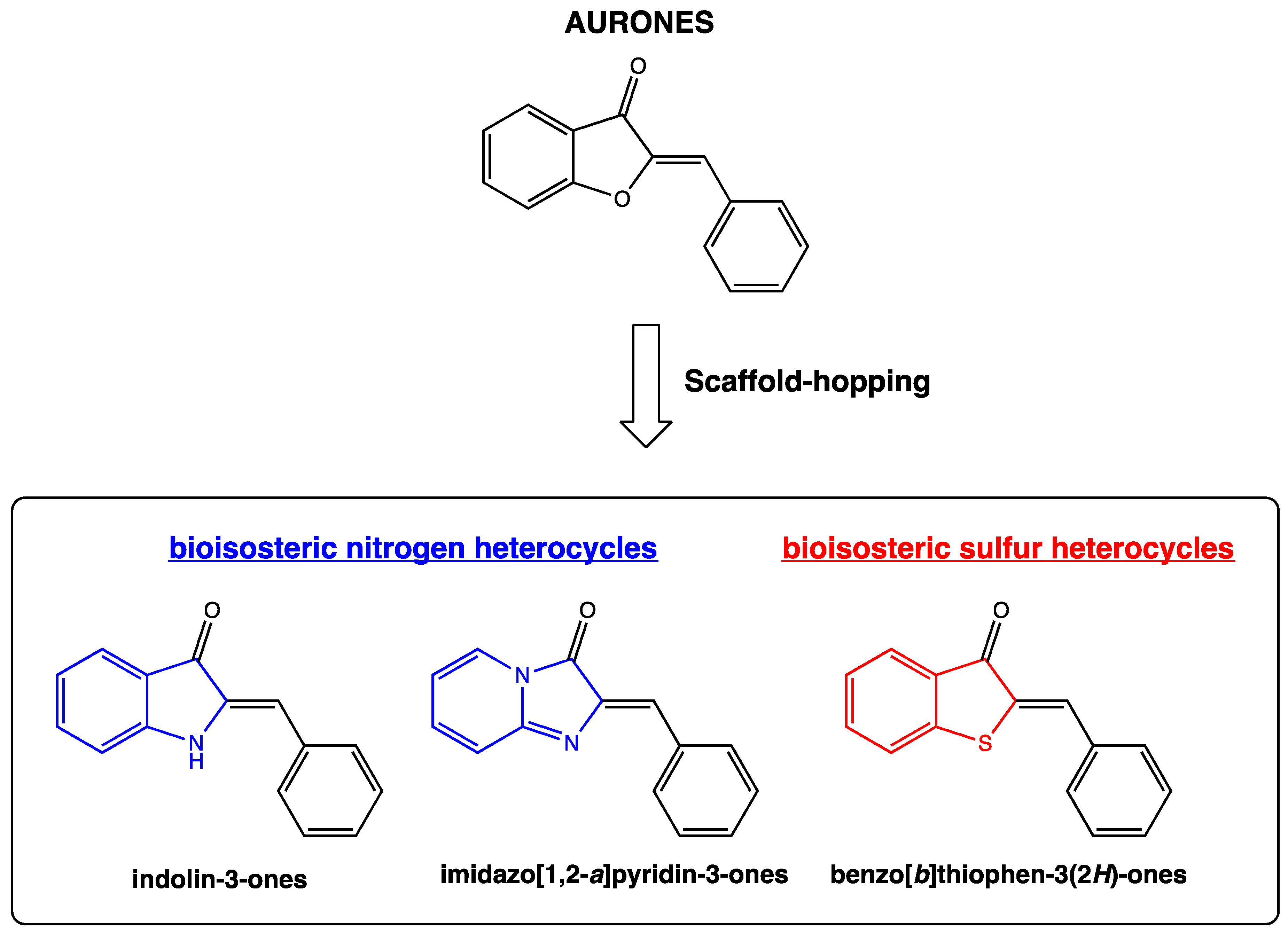

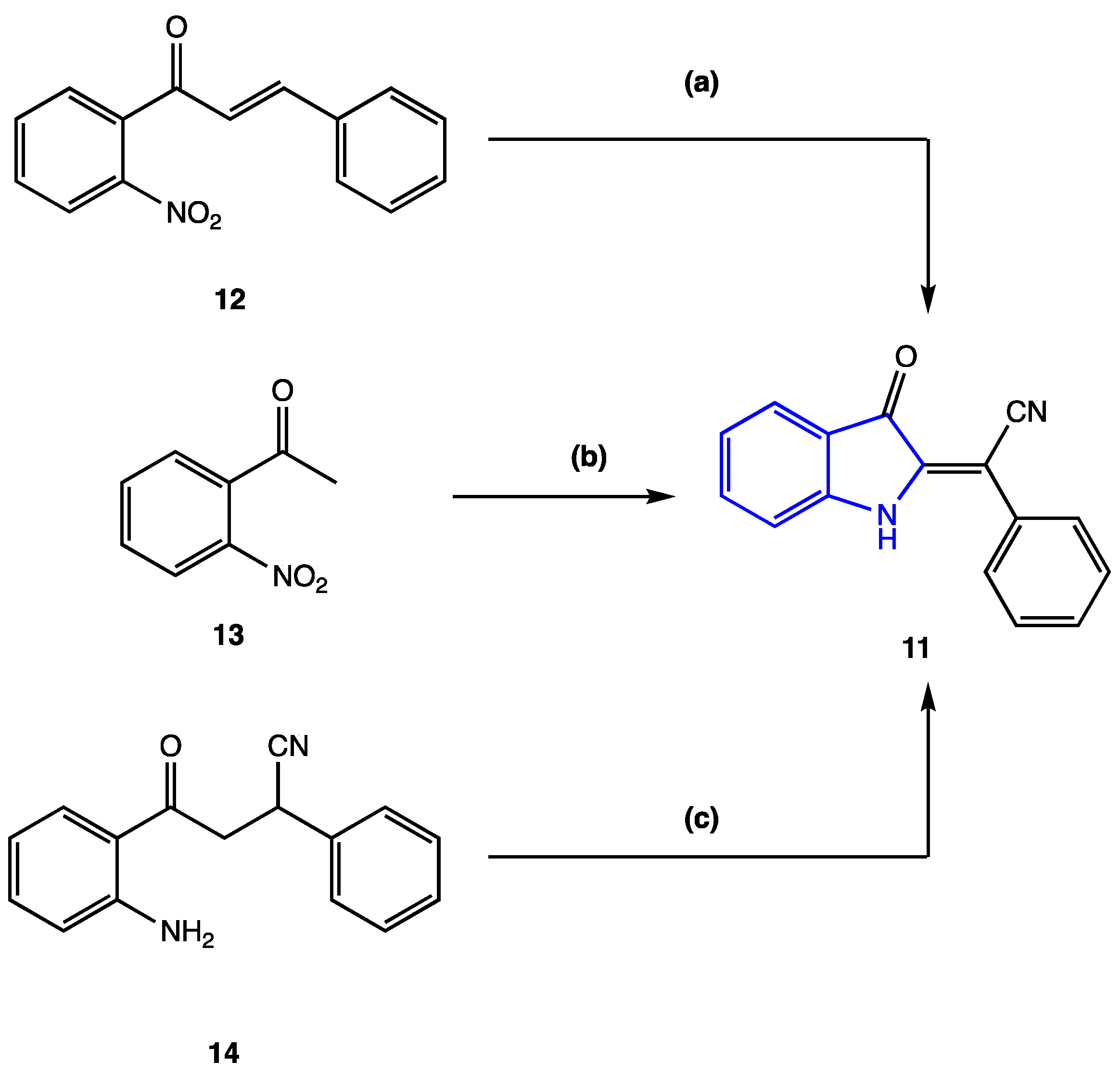

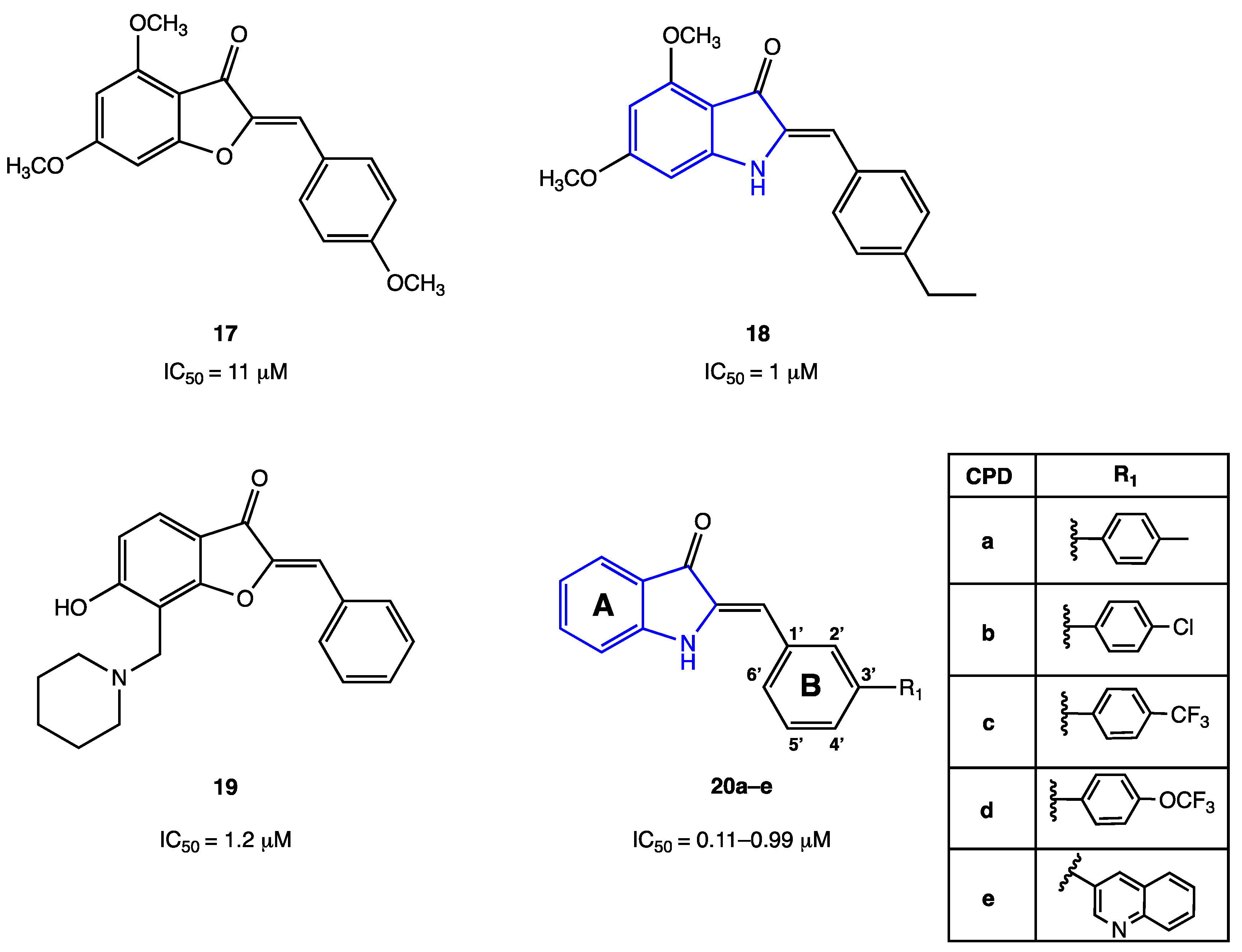


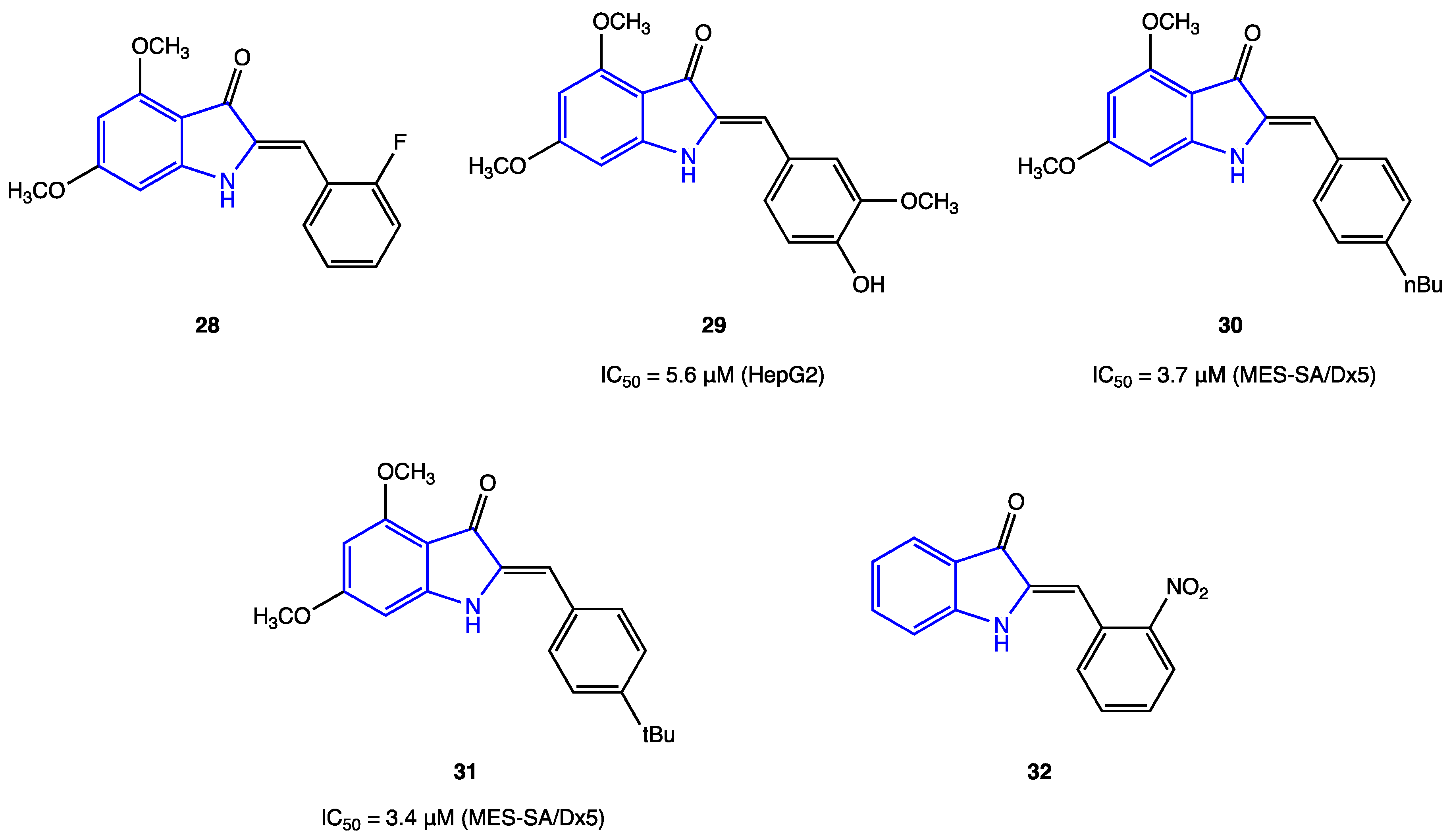
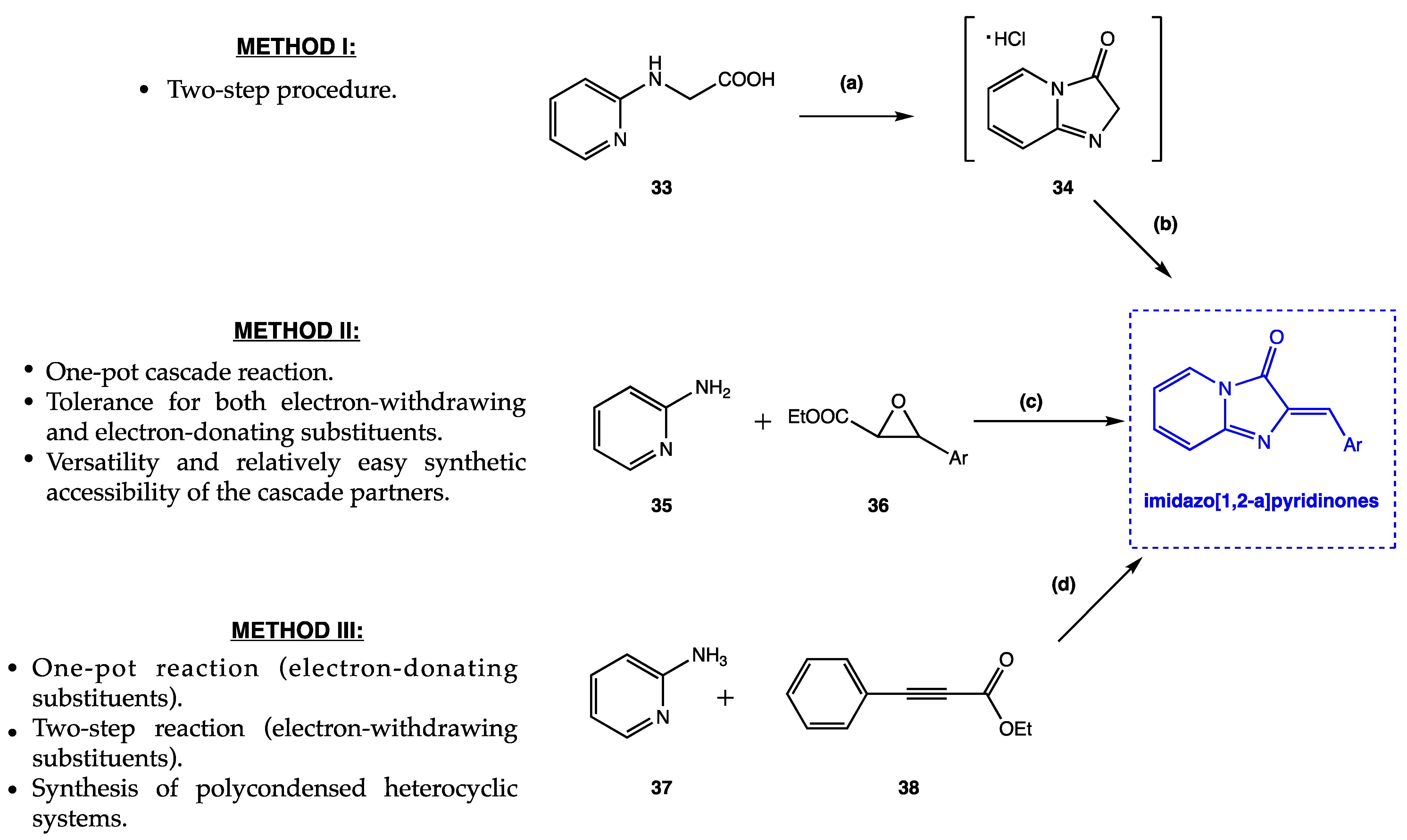
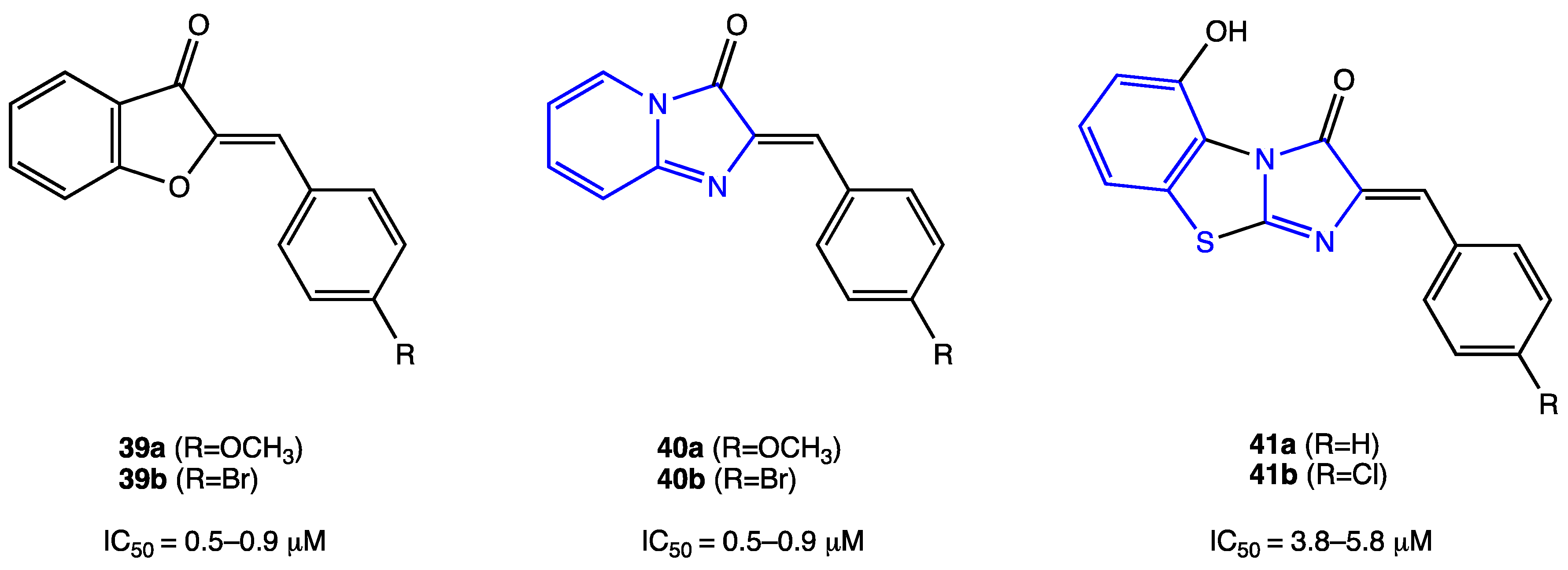
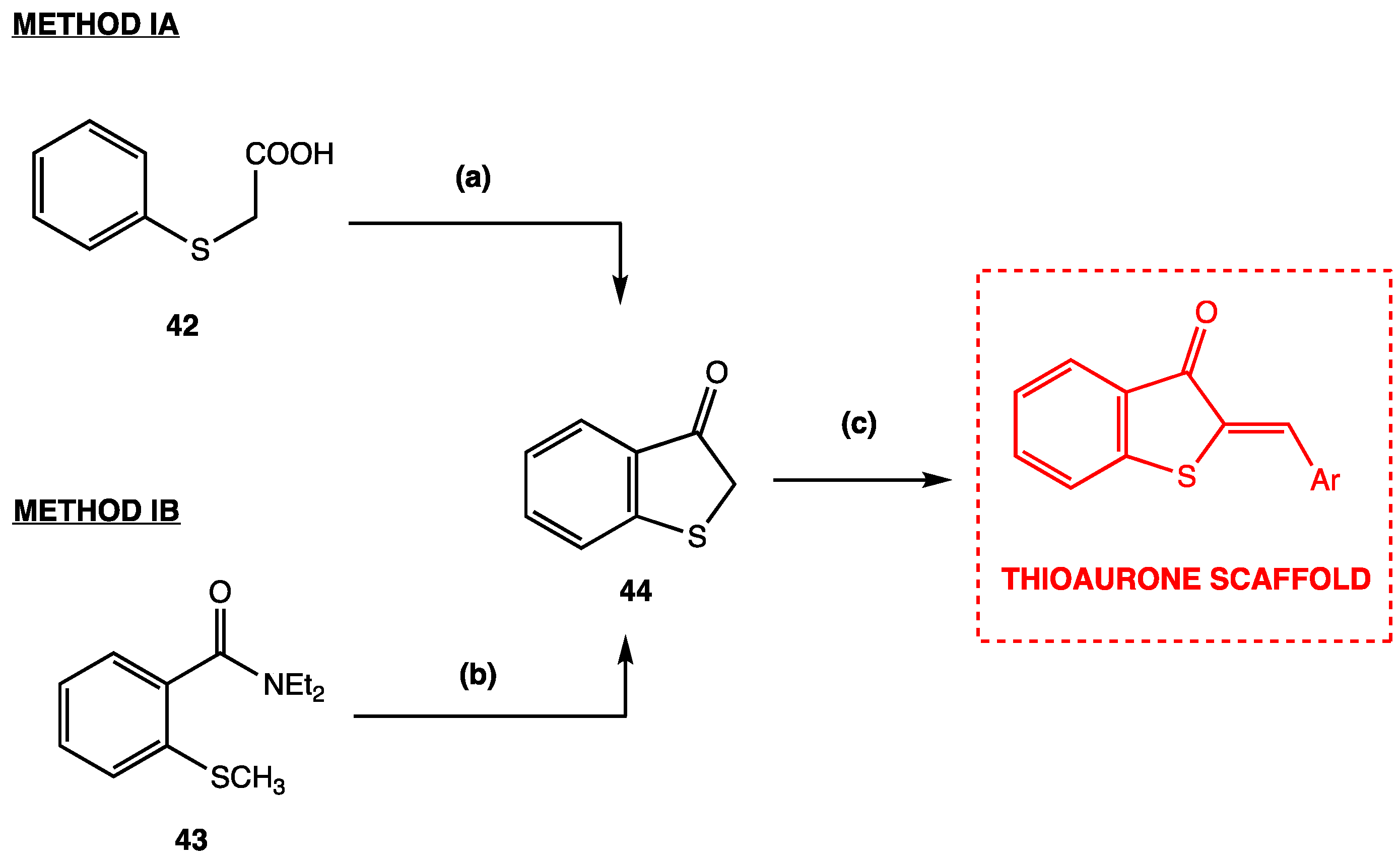
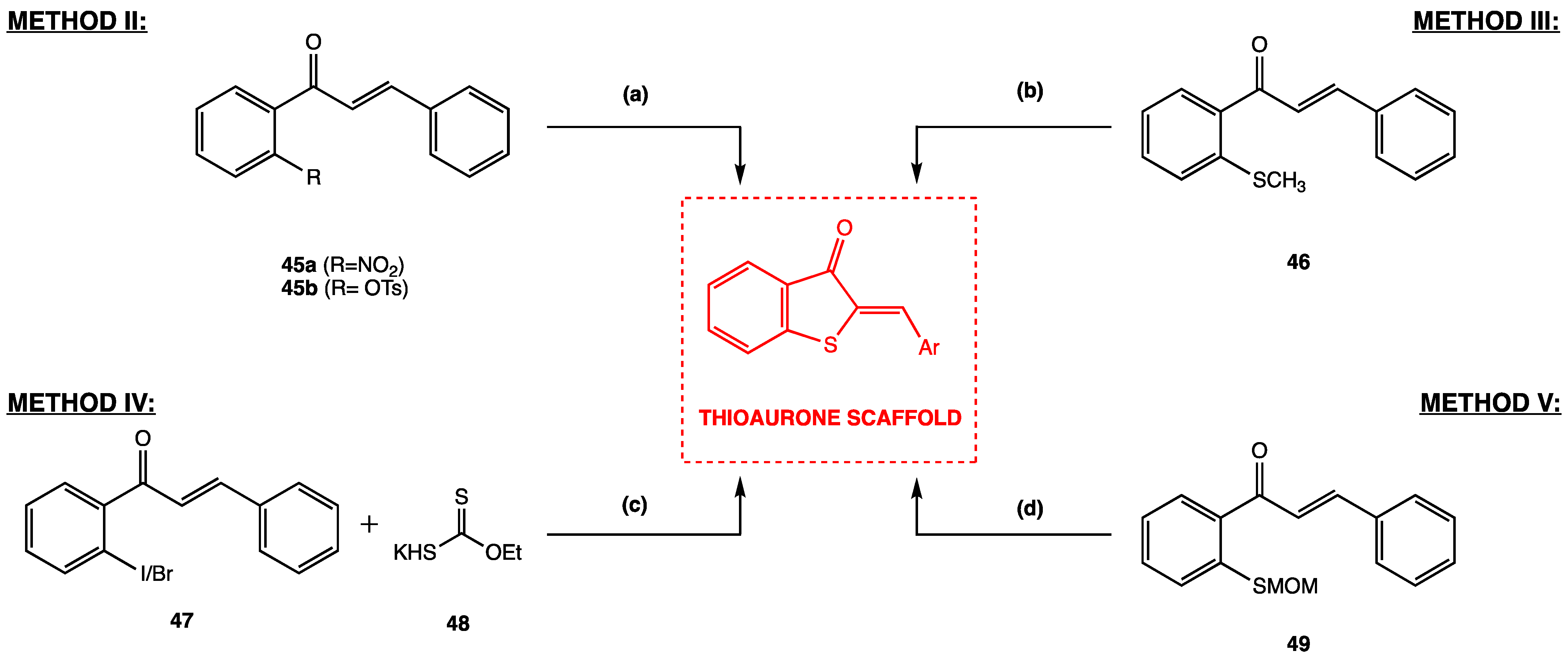

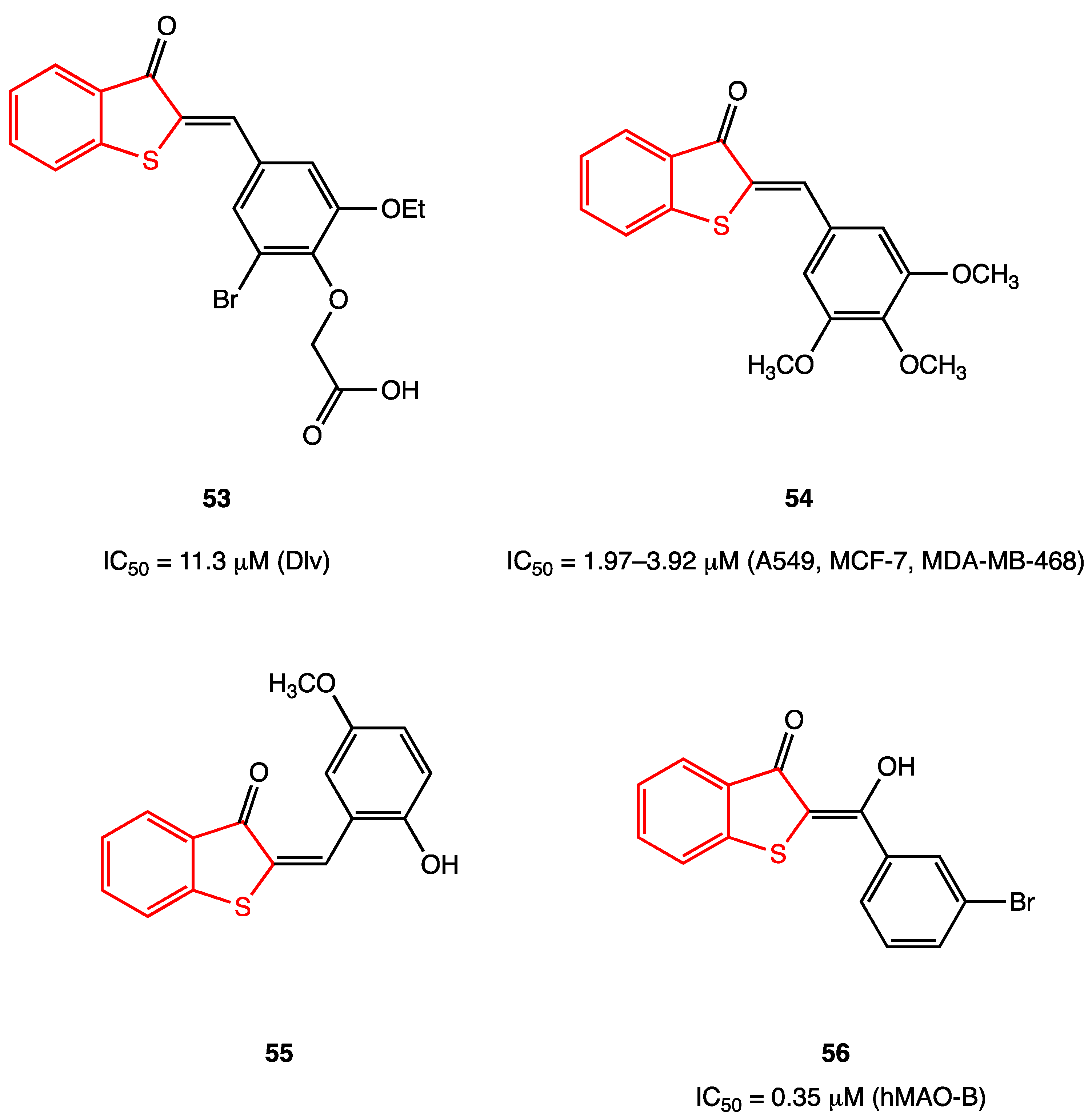
| Synthetic Procedure | Key Points | Ref. |
|---|---|---|
| I–III |
| [19,20,21,22,23,24,25] |
| IV |
| [27,28,29] |
| V–VI |
| [30,31] |
| Synthetic Procedure | Key Points | Ref. |
|---|---|---|
| IA,B |
| [54,55,56,57,58] |
| II–V |
| [61,62,64,65,66] |
| VI–VII |
| [68,69] |
Disclaimer/Publisher’s Note: The statements, opinions and data contained in all publications are solely those of the individual author(s) and contributor(s) and not of MDPI and/or the editor(s). MDPI and/or the editor(s) disclaim responsibility for any injury to people or property resulting from any ideas, methods, instructions or products referred to in the content. |
© 2024 by the authors. Licensee MDPI, Basel, Switzerland. This article is an open access article distributed under the terms and conditions of the Creative Commons Attribution (CC BY) license (https://creativecommons.org/licenses/by/4.0/).
Share and Cite
La Monica, G.; Alamia, F.; Bono, A.; Lauria, A.; Martorana, A. Scaffold-Hopping Strategies in Aurone Optimization: A Comprehensive Review of Synthetic Procedures and Biological Activities of Nitrogen and Sulfur Analogues. Molecules 2024, 29, 2813. https://doi.org/10.3390/molecules29122813
La Monica G, Alamia F, Bono A, Lauria A, Martorana A. Scaffold-Hopping Strategies in Aurone Optimization: A Comprehensive Review of Synthetic Procedures and Biological Activities of Nitrogen and Sulfur Analogues. Molecules. 2024; 29(12):2813. https://doi.org/10.3390/molecules29122813
Chicago/Turabian StyleLa Monica, Gabriele, Federica Alamia, Alessia Bono, Antonino Lauria, and Annamaria Martorana. 2024. "Scaffold-Hopping Strategies in Aurone Optimization: A Comprehensive Review of Synthetic Procedures and Biological Activities of Nitrogen and Sulfur Analogues" Molecules 29, no. 12: 2813. https://doi.org/10.3390/molecules29122813






